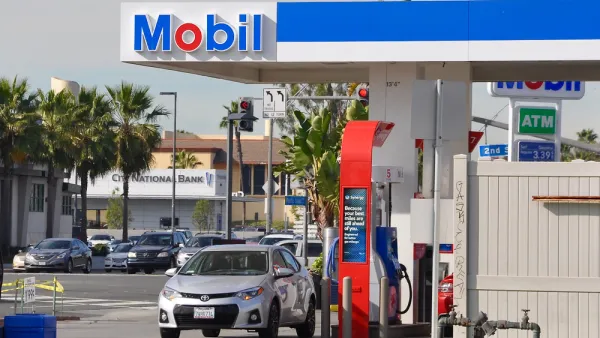Over the weekend, Virginia passed a controversial transportation funding plan that replaces the state's gas tax with a combination of revenue streams. Two California economists look at the flaws with the plan.
Although Virginia Gov. Robert F. McDonnell’s original plan to replace the state’s gas tax with a 16 percent increase in sales taxes didn't fly, the state's legislators have approved a comprose bill that reaches similar ends and some believe "may be even worse."
Fredrick Kunkle and Laura Vozzella break down the final agreement: "The new plan [replaces] the 17.5 cents-per-gallon tax on gasoline — which had not been changed since 1987 — with a new 3.5 percent wholesale tax on motor fuels that will keep pace with economic growth and inflation."
"The deal’s major components also include boosting the sales tax on nonfood merchandise from 5 percent to 5.3 percent and devoting a fatter slice of existing revenue to transportation instead of schools, public safety and other services. And it creates a regional funding mechanism that boosts the sales tax to 6 percent in Northern Virginia and Hampton Roads and requires those funds to be spent only on transportation projects in those areas."
"Supporters praised the plan to raise about $880 million a year, including the new dedicated streams of money for mass transit," add Kunkle and Vozzella, "while opponents spoke out against taxing different parts of the state at different rates or doubling the registration fee on electric cars to $100 and applying it to alternative fuel and hybrid vehicles, too."
In an editorial in The Washington Post, economists Michael Madowitz and Kevin Noonan argue that removing the fixed tax on gasoline at the pump will cause Virginia's transportation revenue to fluctuate drastically.
"Virginia would be best served by an approach that asks people to pay for what they use, assumes inflation will occur and accepts that transportation infrastructure costs money. To do that, all that was needed was indexing the per-gallon gas tax to inflation," they write.
Having studied the effects of a similar approach in California, which experienced a 12 percent fluctuation in revenue difference, Madowitz and Noonan believe the state could have generated a steadier and more predictable revenue stream by taxing motorists at the pump according to inflation.
FULL STORY: Virginia lawmakers approve sweeping transportation plan

National Parks Layoffs Will Cause Communities to Lose Billions
Thousands of essential park workers were laid off this week, just before the busy spring break season.

Retro-silient?: America’s First “Eco-burb,” The Woodlands Turns 50
A master-planned community north of Houston offers lessons on green infrastructure and resilient design, but falls short of its founder’s lofty affordability and walkability goals.

Delivering for America Plan Will Downgrade Mail Service in at Least 49.5 Percent of Zip Codes
Republican and Democrat lawmakers criticize the plan for its disproportionate negative impact on rural communities.

Test News Post 1
This is a summary

Test News Headline 46
Test for the image on the front page.

Balancing Bombs and Butterflies: How the National Guard Protects a Rare Species
The National Guard at Fort Indiantown Gap uses GIS technology and land management strategies to balance military training with conservation efforts, ensuring the survival of the rare eastern regal fritillary butterfly.
Urban Design for Planners 1: Software Tools
This six-course series explores essential urban design concepts using open source software and equips planners with the tools they need to participate fully in the urban design process.
Planning for Universal Design
Learn the tools for implementing Universal Design in planning regulations.
EMC Planning Group, Inc.
Planetizen
Planetizen
Mpact (formerly Rail~Volution)
Great Falls Development Authority, Inc.
HUDs Office of Policy Development and Research
NYU Wagner Graduate School of Public Service



























